If you are interested to learn about the python magic or dunder method
To create connection between Python programming language and MongoDB database, we need to first install pymongo driver. Here, we are creating an example that connects to the database and performs basic database operations.

How do I connect to a MongoDB connection?
To connect to your local MongoDB, you set Hostname to localhost and Port to 27017 . These values are the default for all local MongoDB connections (unless you changed them). Press connect, and you should see the databases in your local MongoDB. This example includes the following steps
How does Python store JSON data in MongoDB?
<strong>“insert json into mongodb python” Code Answer</strong> import json.
from pymongo import MongoClient. client = MongoClient('localhost', 27017)
db = client['countries_db']
collection_currency = db['currency'] with open('currencies.json') as f:1) Install Driver
$ pip install pymongo

2) Create Python File
// connect.p
from pymongo import MongoClient # import mongo client to connect
import pprint
# Creating instance of mongoclient
client = MongoClient()
# Creating database
db = client.javatpoint
employee = {"id": "101",
"name": "Peter",
"profession": "Software Engineer",
}
# Creating document
employees = db.employees
# Inserting data
employees.insert_one(employee)
# Fetching data
pprint.pprint(employees.find_one()) 3) Execute Python Script
This script prints the inserted record on the console.

4) Enter into Mongo Shell
Now, enter into MongoDB database shell to see the created database and collection. We can use following command to enter into the database.
$ mongo
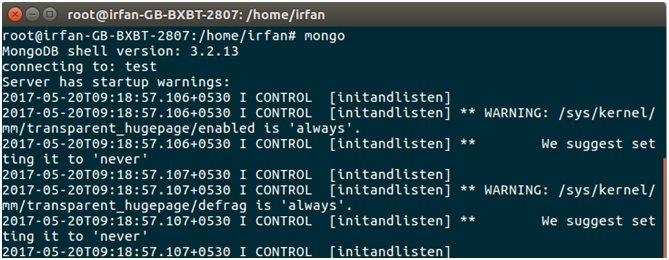
5) Check Databases
The following command is used to show available databases.
> show dbs
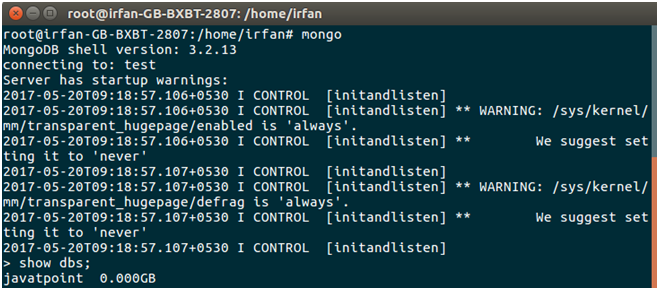
6) Check Collection
The following command is used to show available collection into the database.
> show collections
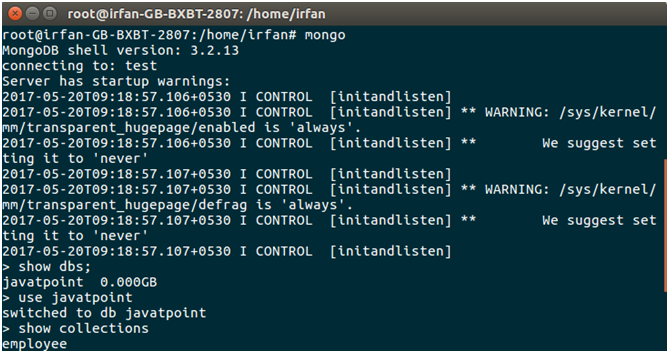
7) Access Records
We can see the stored records in particular collection. The following command is used to show the record.
> db.employees.find()

How MongoDB stores data
MongoDB stores data in JSON-like documents:
# Mongodb document (JSON-style)
document_1 = {
"_id" : "BF00001CFOOD",
"item_name" : "Bread",
"quantity" : 2,
"ingredients" : "all-purpose flour"
}Python dictionaries look like:
# python dictionary
dict_1 = {
"item_name" : "blender",
"max_discount" : "10%",
"batch_number" : "RR450020FRG",
"price" : 340
}Read on for an overview of how to get started and deliver on the potential of this powerful combination.
Prerequisites
Download and install Python on your machine (in this screenshot: Windows. You’ll notice a slight formatting difference if you use another operating system but the result should be the same). To confirm if your installation is right, type ‘python’ in your command line window. You should get:
Python 3.9.0 (tags/v3.9.0:9cf6752, Oct 5 2020, 15:34:40) [MSC v.1927 64 bit (AMD64)] on win32 Type "help", "copyright", "credits" or "license" for more information. >>>
You can follow the python mongodb examples in this tutorial even if you are new to python.
We recommend that you set up a MongoDB Atlas free tier cluster for this tutorial
Connecting Python and MongoDB Atlas PyMongo has a set of packages for Python MongoDB interaction. To install PyMongo, open command line and type:
python -m pip install pymongo
Tip: If you are getting “ModuleNotFoundError: No module named ‘pymongo’” error, uninstall pymongo. Use pip uninstall pymongo command. Then, re-install using the installation command.
For this python mongodb tutorial, we use mongodb srv URI, so let’s install dnspython:
python -m pip install dnspython
Now, we can use pymongo as a python mongodb library in our code with an import statement.
Creating a MongoDB database in Python
The first step to connect python to Atlas is MongoDB cluster setup. Next, create a file named pymongo_test_insert.py in any folder to write pymongo code. You can use any simple text editor like Textpad/Notepad. Create the mongodb client by adding the following:
def get_database():
from pymongo import MongoClient
import pymongo
# Provide the mongodb atlas url to connect python to mongodb using pymongo
CONNECTION_STRING = "mongodb+srv://<username>:<password>@<cluster-name>.mongodb.net/myFirstDatabase"
# Create a connection using MongoClient. You can import MongoClient or use pymongo.MongoClient
from pymongo import MongoClient
client = MongoClient(CONNECTION_STRING)
# Create the database for our example (we will use the same database throughout the tutorial
return client['user_shopping_list']
# This is added so that many files can reuse the function get_database()
if __name__ == "__main__":
# Get the database
dbname = get_database()Use the connection_string to create the mongoclient and get the MongoDB database connection. Change the username, password and cluster name . In this python mongodb tutorial, we will create a shopping list and add a few items. For this, we created a database ‘user_shopping_list’. MongoDB doesn’t create a database until you have collections and documents in it. So, let’s create a collection next.
Creating a collection in Python
To create a collection, pass the collection name to the database. Make sure to have the right indentation while copying the code to your .py file.
collection_name = dbname["user_1_items"]
This creates a collection named user_1_items in the user_shopping_list database.
Inserting documents in Python
For inserting many documents at once, use the pymongo insert_many() method.
item_1 = {
"_id" : "U1IT00001",
"item_name" : "Blender",
"max_discount" : "10%",
"batch_number" : "RR450020FRG",
"price" : 340,
"category" : "kitchen appliance"
}
item_2 = {
"_id" : "U1IT00002",
"item_name" : "Egg",
"category" : "food",
"quantity" : 12,
"price" : 36,
"item_description" : "brown country eggs"
}
collection_name.insert_many([item_1,item_2])Let us insert a third document without specifying the _id field. This time we add a field of data type ‘date’. To add date using pymongo, use the python dateutil package. ISODate will not work with Python, as it is a Mongo shell function. Install the package using the following command: python -m pip install python-dateutil
Add the following to pymongo_test.py:
from dateutil import parser
expiry_date = '2021-07-13T00:00:00.000Z'
expiry = parser.parse(expiry_date)
item_3 = {
"item_name" : "Bread",
"quantity" : 2,
"ingredients" : "all-purpose flour",
"expiry_date" : expiry
}
collection_name.insert_one(item_3)We use the insert_one() method to insert a single document. Open the command line and navigate to the folder where you have saved pymongo_test_insert.py. Execute the file using the python pymongo_test_insert.py command.
Let’s connect to MongoDB Atlas UI and check what we have so far. Login to your Atlas cluster and click on the collections button. On the left side, you can see the database and collection name that we created. If you click on the collection name, you can view the data as well:
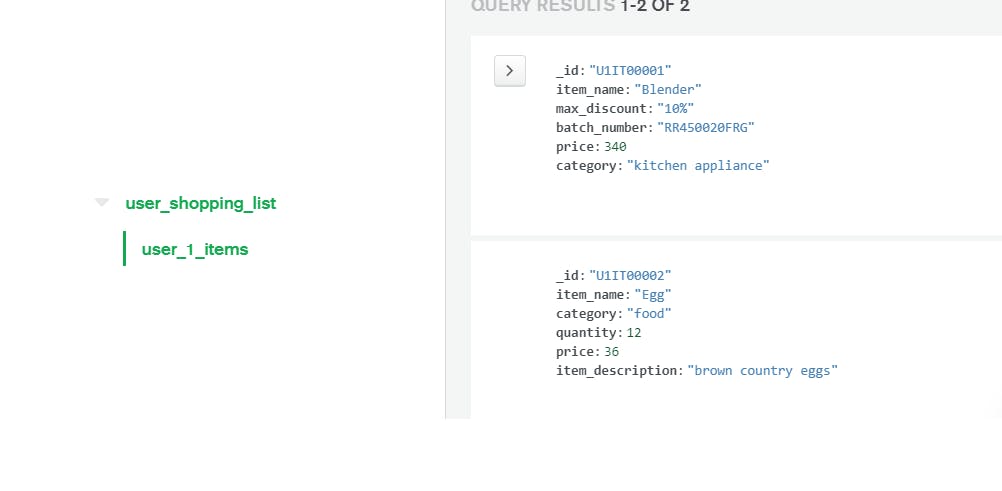
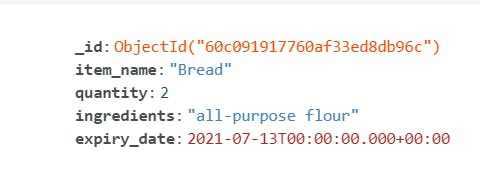
The _id field is of ObjectId type by default. If we don’t specify the _id field, MongoDB generates the same. Not all fields present in one document are present in others. But MongoDB doesn’t stop you from entering data – this is the essence of a schemaless database. If we insert item_3 again, mongodb will insert a new document, with a new _id value. But, the first two inserts will throw an error because of the _id field, the unique identifier.
Querying in Python
Let’s view all the documents together using find(). For that we will create a separate file pymongo_test_query.py:
# Get the database using the method we defined in pymongo_test_insert file
from pymongo_test_insert import get_database
dbname = get_database()
# Create a new collection
collection_name = dbname["user_1_items"]
item_details = collection_name.find()
for item in item_details:
# This does not give a very readable output
print(item)Open the command line and navigate to the folder where you have saved pymongo_test_query.py. Execute the file using the python pymongo_test_query.py command. We get the list of dictionary object as the output:

We can view the data but the format is not all that great. So, let’s print the item names and their category:
print(item['item_name'], item['category'])
Although Mongodb gets the entire data, we get a python ‘KeyError’ on the third document.

To handle missing data errors in python, use pandas.DataFrames. DataFrames are 2D data structures used for data processing tasks. Pymongo find() method returns dictionary objects which can be converted into a dataframe in a single line of code. Install pandas library as:
python -m pip install pandas
Replace the for loop with the following code to handle KeyError in one step:
from pandas import DataFrame # convert the dictionary objects to dataframe items_df = DataFrame(item_details) # see the magic print(items_df)
And don’t forget to comment the print(item['item_name'], item['category']) .The errors are replaced by NaN and NaT for the missing values.

Indexing in Python MongoDB
The number of documents and collections in a real-world database always keep increasing. It can take a very long time to search for specific documents — for example, documents that have “all-purpose flour” among their ingredients — in a very large collection. Indexes make database search faster, efficient, and reduce the cost of querying. For example, sort, count, match etc. MongoDB defines indexes at the collection level. For the index to make more sense, add more documents to our collection. Insert many documents at once using the insert_many() method. For sample documents, copy the code from github and execute python pymongo_test_insert_more_items.py in your terminal.
Let’s say we want the items that belong to the category ‘food’:
item_details = collection_name.find({"category" : "food"})To execute the above query, mongodb has to scan all the documents. To verify this, download Compass. Connect to your cluster using the connection string. Open the collection and go to the Explain Plan tab. In ‘filter’, give the above criteria and view the results:
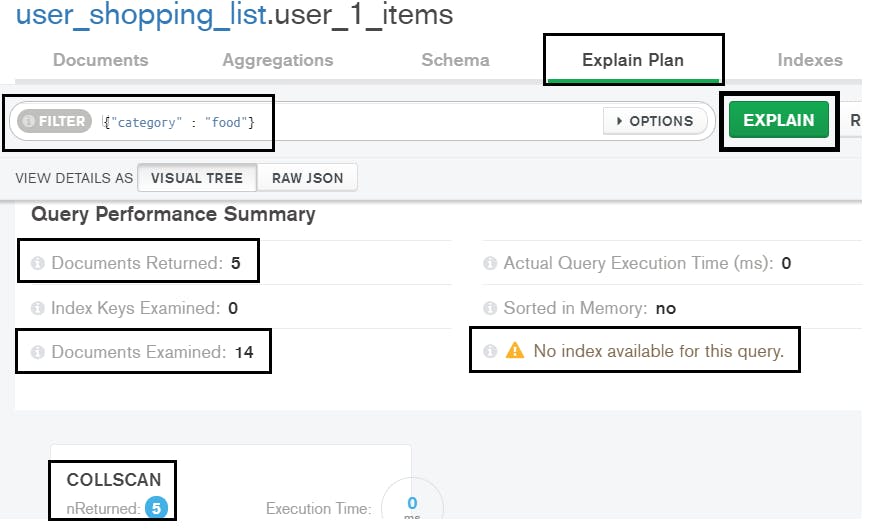
Note that the query scans twelve documents to get three results. Let us create a single index on the ‘category’ field.
category_index = collection_name.create_index("category")Explain the same filter again on Compass UI:

This time only three documents are scanned because of the category index. We don’t see a significant difference in execution time because of fewer documents. But we see a huge reduction in the number of documents scanned for the query. Indexes help in performance optimization for aggregations as well. Aggregations are out of scope for this tutorial, but here’s an overview.


